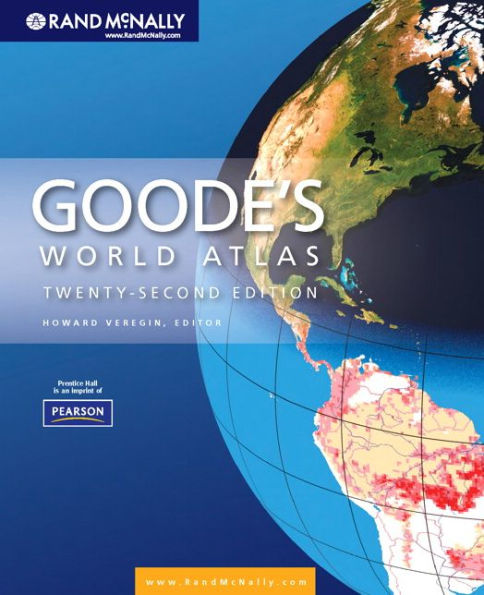Goode’s Atlas is named for John Paul Goode, who created the atlas and served as its editor for many editions. Goode was one of the first U.S. academic cartographers. He was born in rural Minnesota in 1862, received his bachelor’s degree from the University of Minnesota in 1889, and earned his doctorate in economic geography from the University of Pennsylvania in 1903. He spent much of his professional career at the University of Chicago. Among his many accomplishments he is perhaps best known for the development of the Interrupted Homolosine projection, which he first presented at the Association of American Geographers meeting in 1923, and which has been used extensively in
Goode’s Atlas and in many other geographic publications to the present day.
The Homolosine is a composite of two projections, the Mollweide (Homolographic) and the Sinusoidal. Goode interrupted the Homolosine over the oceans to minimize distortion of shapes over continental land masses. Lines of latitude on the Homolosine are straight lines, to facilitate analysis of comparative latitudes. Also, the projection is equal area. Goode was a strong proponent of equal area projections and an equally strong opponent of the Mercator projection, widely used in the early part of the 20th century for world maps. As Goode stated in the introduction to the 1st edition of the atlas (1923, p. x), the distortion of area on the Mercator projection is so extreme that “it becomes pedagogically a crime to use Mercator’s map” for studies of areal distributions such as population density, rainfall, or sizes of countries.
Under Goode’s editorship the atlas doubled in size. The 1st edition of Goode’s School Atlas contained 96 pages of maps. The 4th edition (1932), the last edition that Goode would edit before his death, contained 174 pages of maps. Goode introduced many of the thematic map topics that are still found in the atlas today, including world economic maps of agricultural commodities, minerals, energy, and international trade. These topics reflect Goode’s interest and training in economic geography.
Goode remained the only name on Goode’s School Atlas until the 8th edition (1949), on which Edward B. Espenshade, Jr., was credited with numerous updates and revisions. Espenshade was then named editor for the 9th edition (1953). Espenshade was one of Goode’s students and spent his academic career at Northwestern University in Evanston, Illinois. The 9th edition was significant in many respects. It boasted a new title, Goode’s World Atlas, and contained many of the features of the modern atlas. In particular, Espenshade made extensive use of maps compiled by
experts in specific subdisciplines of geography. Examples include natural vegetation by A. W. Küchler, physiography by Erwin Raisz, climate regions by Glenn Trewartha, and agricultural regions by Derwent Whittlesey. By relying on the research of these and other scholars, Espenshade was able to incorporate the latest advances in the study of geographical phenomena. Espenshade also oversaw the creation of a new reference map series, which included hand-drawn shaded relief for the first time in the atlas. These reference maps were introduced in the 11th edition (1960).
Joel L. Morrison, then at the University of Wisconsin, joined Espenshade as associate editor on the 14th edition (1974). Morrison, who had a distinguished career in academia and the federal government, was affiliated with the atlas through the 19th edition (1995). In the 1970s and 1980s the atlas saw numerous innovations, including the introducti





